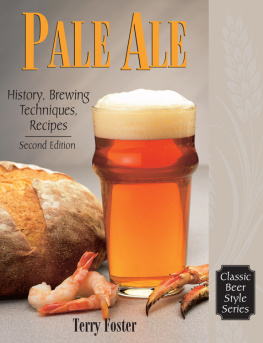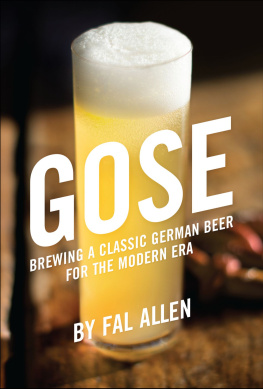There have been many people who have contributed along the way. We would like to thank the following people in particular: Teresa Beddoe, Steve Bradt, Ray Daniels, Mark Dorber, Charles Finkel, Diana Lay, the Elysian Brewing Company, Toby Malina, Greg Noonan, Garrett Oliver, the Pike Brewing Company, Nick Redmon, Fiona Wood, all the brewers who sent us recipes and information, and Rick Buchanan and Phil Rogers.
Back when we worked together, at what was then called the Pike Place Brewery, the day we brewed our barley wine was always a special occasion. Even though it was early fall, we would play Christmas music as we brewed, in allusion to the fact that the beer would not be released until the holiday season was in full swing. It was the only day of the year that we used the lightly peated Scottish distillers malt from Crisp Malting in England in place of our usual Marris-Otter, invariably heaping it above the rim of our tiny mash tun and unleashing a smoky redolence that gave the normally rich smells of brewing a whiskeyish note. There was also something less tangible in the air. From the first mash-in until the last tipping of the hop back to get the final precious quart or two of wort, there was a sense of extra vigilance throughout the brewery as each of us made absolutely certain that we got the most out of every stage in the brew. It was a day of personal sacrifice, as buses were missed and phone calls made, in order that runoff and boil times could be extended in the pursuit of our desired massive starting gravity. And once the beer was in fermentation, each of us would check it daily, nervously monitoring the incremental drops in gravity as we tasted it for signs of greatness.
Because of the extra care taken in their crafting, as well as the extra amounts both of raw materials used and alcohol produced in the course of fermentation, barley wines are beers to make one sit up and take notice. They are beers that both brewers and consumers take seriously, and which require serious attention to detail. But lest it seem that we mean to intimidate, let us be clear that they can be made by mortals of limited means and resources, and made well. We ought to knowthe brewing system on which in those days we brewed Old Bawdy, the Pike Place barley wine, was small, overworked, and cobbled together, but we had excellent raw materials, a wonderful yeast, and a great spirit of cooperation.
To the uninitiated, the very name barley wine seems calculated to confuse. A wine made from barley? Well, sort of. Few of the ales dubbed barley wines are truly in the range of alcoholic content of even sprightly wines, but that is the idea in naming them so. A classic British barley wine was the strongest ale brewed by whatever brewery saw fit to produce one. Often they were produced in connection with noteworthy events such as coronations or the births of royal heirsfitting for ales brewed to starting gravities frequently in excess of 1.100. (By comparison, today the standard British bitter beers typically have starting gravities of 1.035 to 1.040, and industrially produced American lagers have starting gravities (SG) of 1.040 to 1.050.)


In some cases barley wines were brewed only rarely, often commemorating a noteworthy event. These labels celebrated the coronation of Queen Elizabeth II and her twenty-fifth anniversary as Queen of England.
The alcoholic strength of barley wines can run as high as 14% alcohol by volume (ABV). It is true that in modern Britain, owing to a system of taxation based on alcohol content, the strength and durability of many beers calling themselves barley wines have slipped somewhat from the standards established a hundred or so years ago. In America, the supposedly consumer-protective decree handed down by the Bureau of Alcohol, Tobacco, and Firearms specifies that such beers must be designated barley wine-style ales, a distinction that seems to cheapen and diminish the product in question (not unlike requiring distinguished imported beers of more than middling strength be labeled malt liquors).
The centuries-old traditions of European farmhouse brewing used the parti-gyle system, where the first, second, and sometimes third runnings were boiled and brewed separately. The heaviest first runnings of the mash were diverted to the richest (and headiest) of a diminishing succession of brews. Barley wines moved through brewing history somewhat confusingly yoked to other high-gravity or big beers, all typically in the range of 1.090 or more starting gravity and in excess of 8.5% ABV. They were beers to be laid down, like wine, in which the developing and melding flavors would show themselves to best advantage over time. In addition to alcohol and heightened hop flavor, the influence of bacteria and wild yeast could often be marked, especially as storage and maturation in wood was standard. Because of elevated starting gravities and an incomplete understanding of the performance and alcohol tolerance of yeast, they were also frequently sweet, with large amounts of residual sugar.
As an independent style, barley wine made its emergence early in the twentieth century. As commercial forces and trends saw fit to appeal to customers in a more organized and pervasive manner than simple word of mouth, the name barley wine began to appear with greater regularity in print. It was also at this point that most barley wines began to be produced from a single brew rather than as one of a series, as they had been in the past using the parti-gyle system. As such they came to be particularly prized, individual creations conceived and executed as something distinctive and rare, for which premium prices were paid. These beers were stored then served for some special occasion, holiday, or circumstance. Barley wines are now mainly identified with the winter holidays and are frequently grouped with so-called winter ales. American craftbrewers often release them at or in anticipation of Christmastime, a luxurious gift to customers who have been loyal throughout the year. At least this was the way we at Pike Place Brewery treated the unveiling of Old Bawdy. There were precious few quarter-barrel kegs to go around, and we always salted away a case or two with which to addle visiting brewers throughout the year.

















